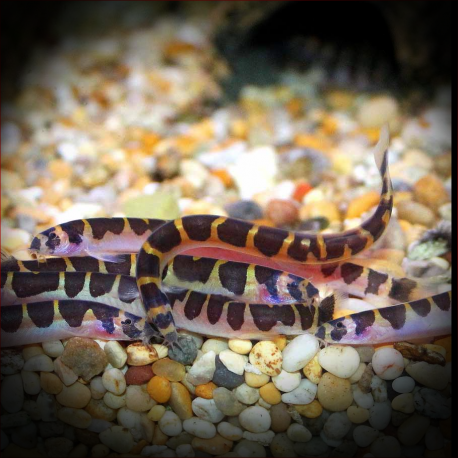More info
Datasheet
| Minimum Tank Size | 40 litres / 10.57 US gallons |
| Maximum Size | 6.0cm / 2.36inches |
| Temperature | 21°C / 69.80°F - 26°C / 78.80°F |
| Hardness | 0.00dgH / 0ppm - 8.01dgH / 143ppm |
| pH | 3.5-7.0 |
General Description
Pangio malayana, commonly known as the Malay Loach, is a peaceful fish species belonging to the Cobitidae family within the Cypriniformes order. These slender-bodied loaches exhibit distinct coloration patterns, including dark saddles along the upper body and a characteristic black bar at the base of the caudal fin. As micropredators, their diet primarily consists of insect larvae, small crustaceans, and organic detritus sourced from sifting through substrate.
Aquarium Setup
When creating a suitable habitat for P. malayana, it is crucial to incorporate a soft, sandy substrate to accommodate their burrowing tendencies. Driftwood, branches, and dried leaf litter can provide both shelter and mimic their natural environment. Optimal tank conditions include dim lighting, temperatures ranging from 21-26°C, and a pH level between 3.5-7.0. Adequate filtration, ensuring small specimens cannot access filter intakes, is recommended, with caution against high flow rates.
Behaviour
Pangio spp. are known for their peaceful demeanor towards tankmates and are often found in aggregations in their natural habitat. In captivity, they tend to congregate in nooks or caves when resting, emphasizing the importance of group sizes of 5-6 individuals. Suitable tankmates include small, peaceful species like Boraras and Sundadanio, although caution is advised with certain sand-dwelling loaches due to potential territorial behaviors.
Feeding and Diet
In the wild, P. malayana feed on live prey such as Daphnia and bloodworms, alongside a diet of extracted insect larvae and plant material from substrate sifting. In captivity, they readily accept sinking dried foods but benefit from regular meals of live or frozen options to supplement their nutritional needs adequately.
Reproduction & Dimorphism
Information regarding the reproduction of P. malayana remains unrecorded. However, sexual dimorphism in mature adults is identifiable, with females showcasing a heavier body and slightly larger size compared to males. Mature males exhibit a branched and thickened first pectoral-fin ray as a distinguishing characteristic.
Habitat and Distribution
Native to Peninsular Malaysia, P. malayana is commonly found in shallow, slow-moving forest streams or calm habitats with a preference for peat, mud, or sandy substrates abundant in leaf litter. Sympatrically found with various fish species in the region, these loaches thrive in shaded, acidic waters with minimal dissolved minerals, such as those found in peat swamps.

